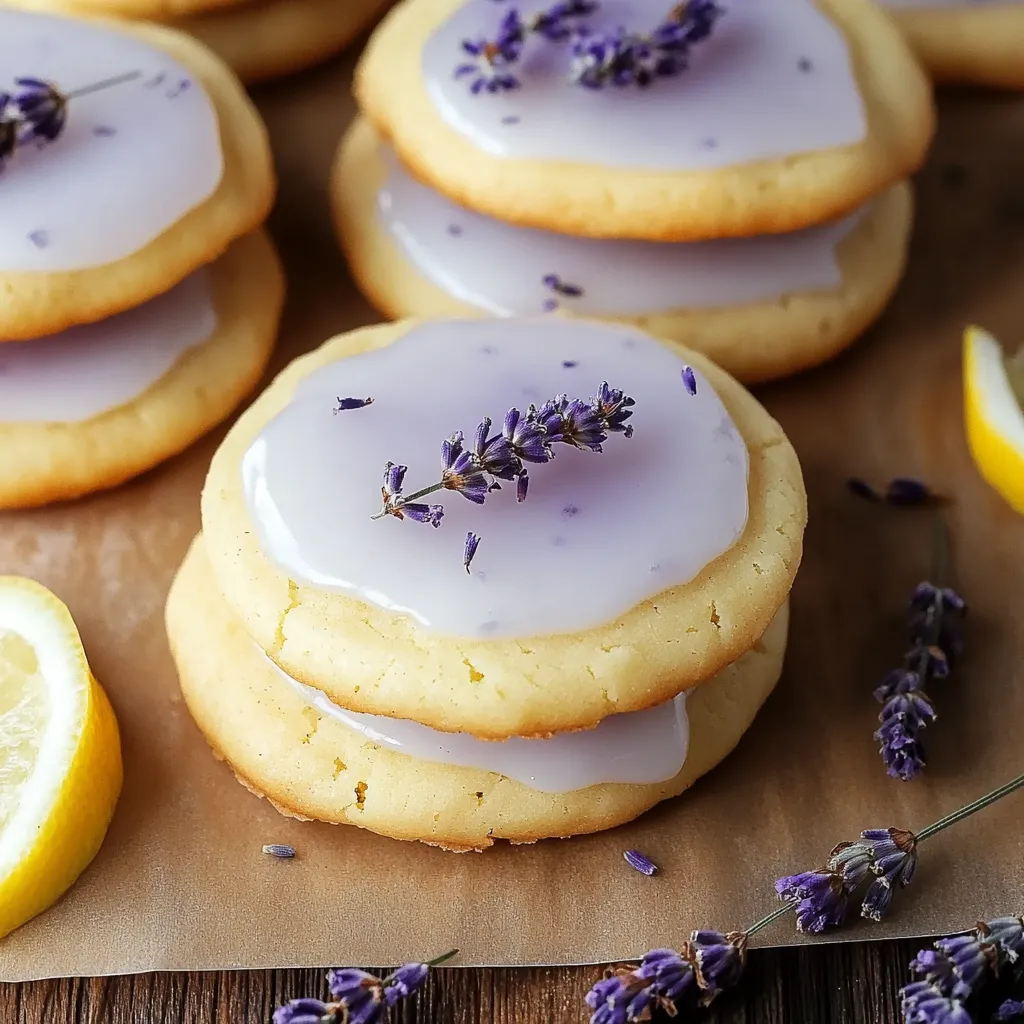 Bookmark
Bookmark
This delicate lemon lavender cookie recipe delivers a perfect balance of floral and citrus flavors in a tender, buttery cookie. The subtle lavender notes complement the bright lemon zest, creating an elegant treat that's perfect for afternoon tea or special occasions.
I first made these cookies for a spring garden party and they disappeared within minutes. My neighbor asked for the recipe three times before I finally wrote it down for her properly!
Ingredients
- All purpose flour provides structure while remaining tender in the final cookie
- Cornstarch is the secret to that melt in your mouth texture that distinguishes these from ordinary sugar cookies
- Baking powder gives just enough lift without making them cakey
- Salted butter adds richness and enhances both the lemon and lavender flavors look for European style with higher fat content for best results
- Granulated sugar provides sweetness and helps create those slightly crisp edges
- Lemon zest use organic lemons if possible for more intense flavor and avoid the white pith which can be bitter
- Dried culinary lavender make sure it's specifically labeled for culinary use regular decorative lavender may be treated with chemicals
- Lavender extract optional but intensifies the floral notes without adding more buds which can make cookies taste soapy
Step-by-Step Instructions
- Prepare your baking sheets
- Line two baking sheets with parchment paper while preheating your oven to 350°F. The parchment prevents sticking and allows for even browning on the bottoms.
- Mix the dry ingredients
- Whisk together flour, cornstarch, and baking powder until completely combined. This step distributes the leavening agent evenly throughout the flour for consistent texture in every cookie.
- Infuse the butter mixture
- Beat butter, sugar, lemon zest, and dried lavender for a full 3 minutes until the mixture becomes noticeably lighter in color. This process incorporates air into the fat and helps the lavender release its essential oils into the butter for maximum flavor.
- Incorporate the egg
- Add the egg and mix until fully incorporated, about 30 seconds. Stop and scrape down the sides of the bowl to ensure everything is evenly mixed. The mixture should look smooth and slightly fluffy.
- Form the dough
- Add the dry ingredients gradually in three additions, mixing just until the flour disappears. Overmixing develops gluten which toughens cookies. The dough should hold together when pressed but might look slightly crumbly.
- Shape the cookies
- Portion dough into tablespoon sized balls and place them on prepared baking sheets. Gently flatten each ball to about half inch thickness to ensure even baking throughout.
- Bake to perfection
- Bake until the edges are just barely turning golden, about 12 to 15 minutes. The centers should look set but not browned. Cookies will continue firming up as they cool.
- Make the glaze
- Whisk powdered sugar with lemon juice until smooth. Start with less liquid and add more as needed the perfect consistency should coat the back of a spoon but still flow slowly.
- Add the finishing touches
- Once cookies are completely cool, drizzle or spread glaze over each one. Immediately sprinkle with additional zest and lavender buds if desired before the glaze sets.
 Bookmark
Bookmark
Lavender is the star ingredient here, but finding the right balance took me several batches of experimentation. My grandmother always grew lavender in her garden, and making these cookies brings back memories of helping her harvest the fragrant purple blooms on warm summer mornings.
Storage Tips
These cookies maintain their texture best when stored in a single layer in an airtight container at room temperature. If you need to stack them, place parchment paper between layers to protect the glaze. While they'll last up to 5 days, the texture is absolute perfection during the first 48 hours.
Flavor Variations
The basic dough recipe works beautifully with other flavor combinations if lavender isn't your preference. Try rosemary with orange zest for a more herbaceous cookie, or replace the lavender with Earl Grey tea leaves for a sophisticated bergamot flavor that pairs wonderfully with the lemon. You can also add white chocolate chips to the original recipe for added sweetness and texture.
Serving Suggestions
These delicate cookies pair perfectly with afternoon tea, especially Earl Grey or a light chamomile. For a special dessert, sandwich vanilla bean ice cream between two cookies and freeze for 30 minutes before serving. They also make a lovely addition to a dessert charcuterie board alongside fresh berries and lemon curd.
Recipe FAQs
- → Can I use fresh lavender instead of dried culinary lavender?
Fresh lavender isn't recommended for these cookies as it contains more moisture and stronger oils that can make your cookies taste soapy. Always use dried culinary-grade lavender, which has been specifically prepared for food use and offers a more balanced flavor.
- → How do I store these lemon lavender cookies?
Store the cookies in an airtight container at room temperature for up to 5 days. If you've applied the glaze, make sure it's completely set before stacking them with parchment paper between layers to prevent sticking.
- → Can I freeze the cookie dough?
Yes! You can freeze the dough for up to 3 months. Either form the dough into a log, wrap tightly in plastic wrap and slice before baking, or portion into individual balls, freeze on a tray, then transfer to a freezer bag. When ready to bake, you can bake directly from frozen, just add 1-2 minutes to the baking time.
- → What if I don't have lavender extract for the glaze?
The lavender extract is completely optional and primarily enhances the visual purple color and boosts the lavender flavor. The cookies will still have lovely lavender notes from the dried buds in the dough. You can substitute with a drop of vanilla extract or simply omit it altogether.
- → How finely should I chop the dried lavender?
You don't need to chop the dried lavender - the small buds can be used whole. However, if you prefer a more subtle distribution of flavor, you can lightly crush the buds between your fingers before adding them to the dough. This releases the oils without creating hard pieces in your cookies.
- → Can I make these cookies without a stand mixer?
Absolutely! While a stand mixer makes the process easier, you can use a hand mixer or even mix by hand with a wooden spoon. If mixing manually, make sure your butter is properly softened to achieve the right creamy texture when combined with the sugar.
